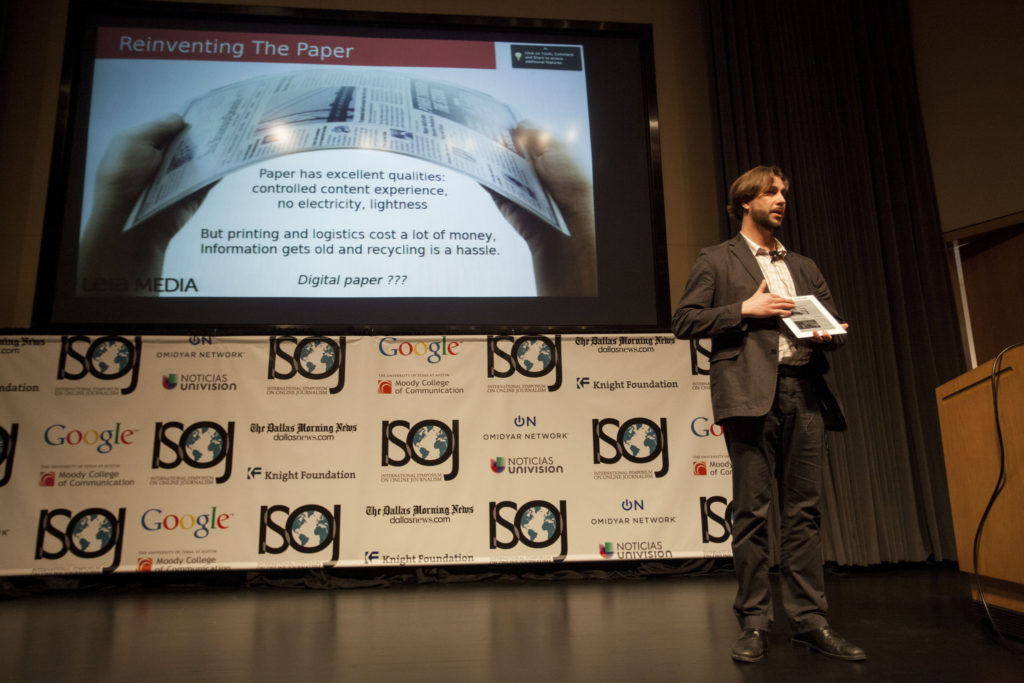April 4, 2014 | Business Models
ISOJ panel explores life beyond the newspaper as a paper only product

What does the future hold for newspapers? Has paper media become obsolete in the face of an increasingly digital print medium? The question of what traditional and community newspapers can do to survive the internet is what was discussed at “Life beyond the newspaper as a paper-only product: Strategies for the newspaper as a hybrid of atoms and bits,” the fifth panel at the 15th International Symposium of Online Journalism’s (ISOJ) first day.
Jim Moroney, CEO at media company A.H. Belo and publisher at The Dallas Morning News, began the panel with the question that held the panel’s focus throughout: how do you balance print and digital when you’re a local news organization? With web impressions needing to scale to around 800 million page views to work economically, it’s hard for local and community newspapers to maximize profits in their digital outlets.
Penelope Abernathy, Knight Chair in Journalism and Digital Media Economics at University of North Carolina at Chapel Hill, said that due to high cost of printing and distribution, as well as shifting reader habits, print ads shrunk to 1950s levels. In a business that has historically placed 80 percent of its revenue in advertising, newspapers need to rethink what represents a “community newspaper” today and go beyond circulation numbers. In order to survive they have to adapt for new preferences while retaining the loyalty of their readers, Abernathy said, who added that advertising departments in general are behind in adapting to the change in newsrooms.
For Jim Brady, current editor-in-chief at Digital First Media and former president of the Online News Association, the future of newspapers is “clearly digital.”
“Customers will move towards what is flexible and they can personalize the most,” he pointed out, adding that the best thing Digital First Media did was centralize their services, allowing for innovation and scalability.
Digital Media First owns over 800 multi-platform products including web, mobile, tablet and print, including the Denver Post, which has won Pulitzers in the past four years for work largely done online, giving credit to Brady’s claim that “innovation is tough, but it needs to be done.” An example of this was the Denver Post’s coverage of the 2012 Aurora shooting, which happened after the paper was sent to print, leading to the immediate coverage being done online.
“Sometimes it can seem like newspaper innovation is the red shirt on Star Trek: always the first to die,” he said at the end of his talk. “But the ultimate way to success is to keep trying and failing. “
Following this positive line of thinking was Caroline Little’s presentation. The current president and CEO of the Newspaper Association of America highlighted the quick and vast spread of media platforms, leading to a more diverse and constantly growing audience.
With 79 million people reading the news on an average weekday, and 18-24 year olds accounting for 46 percent of those, Little said that “the internet has been one of the best things to happen to the American consumer.”
“It’s important not to get involved in the ‘print vs. media’ debate, because from a reader’s standpoint it doesn’t matter where you’re getting your news from,” she said.

But the presentation that really got the audience talking was Valterri Halla’s talk on the product his startup, Leia Media, is working on. Live Paper would be a flexible newspaper-like digital reader that would replace the paper-based news media.
“We’re not bringing this in to replace the tablet, but to compliment it,” he said. Depending on the publisher’s desires, it would work either like an online version of the newspaper, or a tablet’s app, he added.
“Rewrite the rules, get what you want not what they give you,” Halla said.
With the exception of Little, who believed that newspaper will keep being published as long as she’s around, most of the panelists agreed that the newspaper industry does have an expiration date in terms of publishing. They differed on their estimates as to what that expiration date may be, but they did seem to agree that a focus on digital media is essential for the future of journalism.
ISOj 2014: Beyond Newspaper Q&A, from Knight Center and Vimeo.

